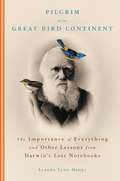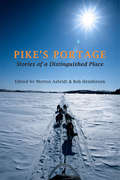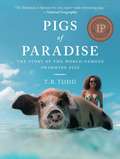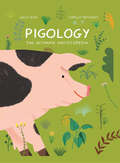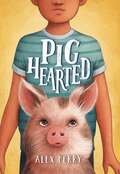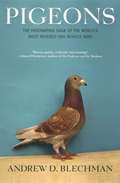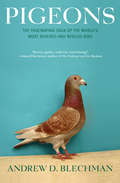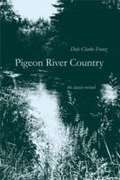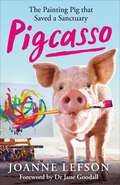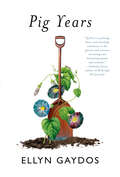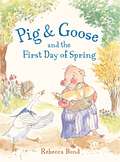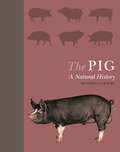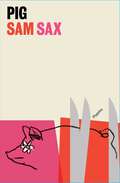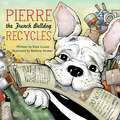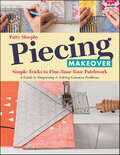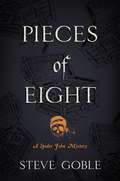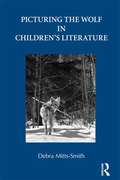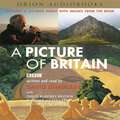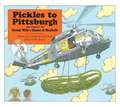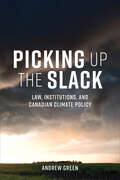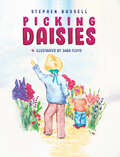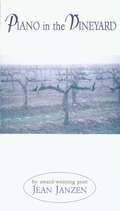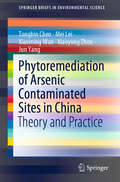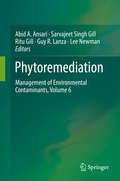- Table View
- List View
Pilgrim on the Great Bird Continent: The Importance of Everything and Other Lessons from Darwin's Lost Notebooks
by Lyanda Lynn HauptSeattle-based environmental writer and ethicist Haupt considers Charles Darwin not just as a bearer of natural selection theory, but as a human who both understand and related to the natural world in such a way that this theory became possible. She draws from his little known Ornithological Notes, published only in 1963, to show how he attained his intellectual and moral maturity through studying the birds of South America. She has not indexed her work. Annotation ©2006 Book News, Inc., Portland, OR (booknews.com)
Pike's Portage: Stories of a Distinguished Place
by Morten Asfeldt Bob Henderson"Pike’s Portage plays a very special role in the landscape of Canada’s Far North and its human history. It is both an ancient gateway and the funnel for early travel from the boreal forest of the Mackenzie River watershed to the vast open spaces of the subarctic taiga, better known as the "Barren Lands" of Canada. "This book is a rich and wonderful comopendium of stories about this area and the early white explorers, the Dene guides, the adventurers, the trappers, the misguided wanderers (like John Hornby) as well as the modern-day canoeists who passed this way. For the reader, it provides an absorbing escape into the past and the endless solitude of the northern wilderness." – George Luste, wilderness canoeist, physics professor (University of Toronto), and founder-organizer of the annual Wilderness Canoeing Symposium. "So why do people come to this place, this Pike’s Portage in particular? The call of landscape is potent and these word portraits collected here offer up some of those who have answered. Both subject and writer reveal the complexities of human perception. Some are called by the profound power of inherited cultural meaning, while a huge dose of imagination draws others from far away. These worlds seldom truly meet, even in a place as busy as this, but whether it is homeland or wilderness, human histories are recorded in footprints, place names, and memory, and here we stand with a magnificent view, marvelling at it all." – Susan Irving, Curatorial Assistant, Prince of Wales Northern Heritage Centre, Yellowknife, NWT
Pigs of Paradise: The Story of the World-Famous Swimming Pigs
by T. R. Todd“The Bahamas are famous for sun, sand—and swimming pigs.” —National GeographicIn the middle of paradise, with billionaires and celebrities for neighbors, is an island populated only by swimming pigs. For decades, this archipelago of 365 islands would remain largely unknown to the world. It would not be a ruthless pirate, pioneering loyalists, a notorious drug kingpin, or the infamous Fyre Festival that would unveil Exuma to the world, but rather the most unlikely of creatures. Appearing in magazines, videos, newspapers, commercials, TV shows, and countless selfies, the Swimming Pigs of Exuma, in the Bahamas, have become a bucket-list sensation and have been named one of the marvels of the universe. But how did they reach this celebrity status? What made them so famous? And why, in February 2017, did so many of them die? Pigs of Paradise is an unlikely story of humble beginnings and a swift rise to stardom. With interviews from historians, world-renowned ecologists, famous pig owners, and boat captains, it thoughtfully considers what this phenomenon says about not only these animals but also about us.
Pigology: The Ultimate Encyclopedia
by Daisy Bird Camilla PintonatoWelcome to the wonderful world of pigs! Pigology is filled with incredible pig facts told in a playful tone by Daisy Bird with irresistibly charming illustrations by rising star Camilla Pintonato.Pigs are full of unexpected surprises. Did you know that when a pig is happy, it will uncoil its curly tail and wag it just like a dog? Or that feral hogs can detect odors from seven miles away? Pigology delves into the history of pigs, pig breeds around the world, famous pigs, pigs in culture, and so much more, with engaging scenes from illustrator Camilla Pintonato. This lively, visual encyclopedia, a follow-up to Chickenology, has something to discover for everyone young and old: nature and animal loving young readers, pig enthusiasts, pig farmers, and pet pig owners alike!
Pighearted
by Alex PerryCharlotte's Web meets My Sister's Keeper in this charming story told from the alternating perspectives of a boy with a fatal heart condition and the pig with the heart that could save his life.Jeremiah&’s heart skips a beat before his first soccer game, but it&’s not nerves. It&’s the first sign of a heart attack. He knows he needs to go to the hospital, but he&’s determined to score a goal. Charging after the ball, he refuses to stop…even if his heart does.J6 is a pig and the only one of his five brothers who survived the research lab. Though he's never left his cell, he thinks of himself as a therapy pig, a scholar, and a bodyguard. But when the lab sends him to live with Jeremiah's family, there&’s one new title he&’s desperate to have: brother.At first, Jeremiah thinks his parents took in J6 to cheer him up. But before long, he begins to suspect there's more to his new curly-tailed companion than meets the eye. When the truth is revealed, Jeremiah and J6 must protect each other at all costs—even if their lives depend on it.
Pigeons: The Fascinating Saga of the World's Most Revered and Reviled Bird
by Andrew D. BlechmanFrom the Book Jacket: They have been worshiped as fertility goddesses and revered as symbols of peace. Domesticated since the dawn of man, they have been crucial to wartime communications for every major historical superpower from ancient Egypt to the United States and are credited with saving thousands of lives. One delivered the results of the first Olympics in 119 B.C. and another brought the news of Napoleon's defeat at Waterloo more than 2,500 years later. Charles Darwin relied heavily upon them to help formulate and support his theory of evolution. Yet the pigeon is reviled today as a rat with wings. How did we come to misunderstand one of mankind's most steadfast companions? In Pigeons, Andrew D. Blechman travels across the United States and Europe in a quest to chronicle the bird's transformation from beloved friend to feathered outlaw. From Brooklyn's Main Event, the pigeon world's equivalent of the Kentucky Derby, to the eighty-third Grand National, with its thousands of bizarre and beautiful show pigeons, and from a pigeon shoot where people pay to gun down live birds, to the nation's oldest and biggest squab farm, Blechman takes the reader deep into the weird and wonderful world of pigeon fanaticism. He meets with pigeon fanciers and pigeon haters alike, includingthe Queen of England's Royal Loft Manager and members of the radical "pro-pigeon underground"; chases Mike Tyson, America's most famous pigeon lover; and for the first time tells the remarkable story behind this seemingly unremarkable bird. You'll never look at a pigeon the same way again. ! ANDREW D. BLECHMAN is an award- winning journalist who has worked for the Los Angeles Times and the Des Moines Register. His writing has appeared in numerous publications, including Smithsonian magazine and The New York Times. He currently divides his time between Berkshire County, Massachusetts, and Germany.
Pigeons: The Fascinating Saga of the World's Most Revered and Reviled Bird
by Andrew D. BlechmanPigeons have been worshipped as fertility goddesses and revered as symbols of peace. Domesticated since the dawn of man, they’ve been used as crucial communicators in war by every major historical superpower from ancient Egypt to the United States and are credited with saving thousands of lives. Charles Darwin relied heavily on pigeons to help formulate and support his theory of evolution. Yet today they are reviled as "rats with wings.” Author Andrew D. Blechman traveled across the United States and Europe to meet with pigeon fanciers and pigeon haters in a quest to find out how we came to misunderstand one of mankind’s most helpful and steadfast companions. Pigeons captures a Brooklyn man’s quest to win the Main Event (the pigeon world’s equivalent of the Kentucky Derby), as well as a convention dedicated to breeding the perfect bird. Blechman participates in a live pigeon shoot where entrants pay $150; he tracks down Mike Tyson, the nation’s most famous pigeon lover; he spends time with Queen Elizabeth’s Royal Pigeon Handler; and he sheds light on a radical "pro-pigeon underground’ in New York City. In Pigeons, Blechman tells for the first time the remarkable story behind this seemingly unremarkable bird.
Pigeon River Country: A Michigan Forest
by Franz Dale ClarkeThe long awaited new edition of a classic offers memories, myths, and meanings of the largest contiguous piece of wild land in Michigan's Lower Peninsula. This updated edition explores more deeply why and how the outdoors moves and compels us. It’s a book about mice who sing, elk who wear collars, deer who kiss, and birds who could dictate their compositions to Mozart. It's about the human species interacting in generous and sometimes misguided ways with the rest of life. It's about men trying to ripen pinecones into pineapples and women taking better aim with a revolver than expected. It's about poetry—from Mary Oliver, Lao Tzu, and Theodore Roethke—and seeing hawks dive in a night sky or feeling oil geologists shake the earth below. It's about finding fish dead in the river by the thousands and crouching behind a stump to watch beaver build a dwelling. While this book considers life beyond the boundaries of Pigeon River Country, it is steeped in the specifics of a place that lives mostly on its own, instead of human, terms. The Pigeon River Country is a remote northern forest, ecologically distinct from most of the United States. Laced with waterways, it has a storied past. Dale Clarke Franz has collected personal accounts from various people intrigued with the Pigeon River Country—including loggers, conservationists, mill workers, campers, even the young Ernest Hemingway, who said he loved the forest "better than anything in the world. " There are comprehensive discussions of the area's flora and fauna, guides to trails and camping sites, and photos showcasing the changing face of this hidden national treasure.
Pigcasso: The painting pig that saved a sanctuary
by Joanne LefsonWhen Joanne Lefson took on a piglet at her animal shelter, the young sow proceeded to eat everything in her stable but a paint brush. In a flash of inspiration, Joanne attempted to introduce the pig to the art of painting - and thus Pigcasso was born. Starting out with a humble canvas on the sanctuary wall, Pigcasso's paintings are now owned by the likes of George Clooney, she has a Swatch watch design partnership, a wine label, and has eclipsed the previous world record holder for animal art. She's been commissioned by Nissan and has had exhibitions in Cape Town, Munich and Amsterdam. More than that, Pigcasso's art funds the food and veterinary services for all the animals at the sanctuary.Pigcasso is the story of this unique pig and of the circumstances that brought her and Joanne together to take the art world by storm and form a unique and unbreakable bond.
Pig Years
by Ellyn GaydosThis captivating memoir is a &“startling testimony to the glories and sorrows of raising and harvesting plants and animals&” (Anthony Doerr, best-selling author of All the Light We Cannot See), as an itinerant farmhand chronicles the wonders hidden within the ever-blooming seasons of life, death, and rebirth.Pig Years catapults American nature writing into the 21st century, and has been hailed by Lydia Davis and Aimee Nezhukumatathil as &“engrossing&” and &“a marvel.&” As a farmer in Upstate New York and Vermont, Ellyn Gaydos lives on the knife edge between loss and gain. Her debut memoir draws us into this precarious world, conjuring with stark simplicity the lifeblood of the farm: its livestock and stark full moons, the sharp cold days lives near to the land. Joy and tragedy are frequent bedfellows. Fields go barren and animals meet their end too soon, but then their bodies become food in a time-old human ritual. Seasonal hands are ground down by the hard work, but new relationships are formed, love blossoms and Gaydos yearns to become a mother. As winter&’s dark descends, Pig Ears draws us into a violent and gorgeous world where pigs are star-bright symbols of hope and beauty surfaces in the furrows, the sow, even in the slaughter. In hardy, lyrical prose that recalls the agrarian writing of Annie Dillard and Wendell Berry, Gaydos asks us to bear witness to the work that sustains us all and to reconsider what we know of survival and what saves us. Pig Years is a rapturous reckoning of love, labor, and loss within a landscape given to flux.
Pig & Goose and the First Day of Spring
by Rebecca BondFind Pig and Goose a place on the friendship shelf with the likes of Frog and Toad, Elephant and Piggie, and Houndsley and Catina. —Kirkus ReviewsAn unlikely friendship springs to life with good humor, kindness, and compassion. In this early reader with five short chapters, emerging readers meet Pig and Goose. Pig is happy. She loves to dance. She loves to eat. But she cannot fly. And she cannot swim. Goose can fly like a bird. Goose can glide across the water beautifully. But he cannot tell stories or host a party like Pig can. Pig and Goose are very different. But what they do have in common is that they like each other. And they love springtime.Simple text and charming illustrations guide beginning readers throughout the story and encourage independent reading.
The Pig: A Natural History
by Richard LutwycheA comprehensive, richly illustrated introduction to the fascinating natural history of the pig, from prehistory to the present At any given time, there are around one billion pigs in the world; that's one for every seven of us. And where would we be without them? Prolific, ubiquitous, smart, adaptable, and providers of high-quality protein, pigs have been our companions since neolithic times, when they obligingly domesticated themselves, coming in from the wild to root around our waste pits. But it's not all about the bacon; today, bred in micro sizes, the resourceful pig has developed a whole new career as a popular pet. And thanks to genome mapping, we now know that the pig shares many common physiological features with humans, spurring the use of pig tissue and organs in medical research and surgery. Beautifully designed and illustrated, The Pig provides a snout-to-tail natural history of this important species, from the prehistoric "hell pig" to today's placid porker, covering the pig's evolution and domestication, anatomy and biology, behavior, role in human life and culture, and breeds. The book also features an engrossing and visually stunning photographic gallery of some thirty popular breeds from around the world, with essential information about each. Filled with surprising facts and insights, The Pig will delight anyone who loves these animals and wants to understand them better. Provides a comprehensive, richly illustrated introduction to the pig's evolution and domestication, anatomy and biology, behavior, role in human life and culture, and breeds. Features infographics, diagrams, and 250 stunning color photographs. Includes a beautiful photographic directory to some 30 popular breeds from around the world, with essential information about each
Pig: Poems
by Sam SaxFrom the brilliantly talented National Poetry Series and James Laughlin Award winner comes a third collection of poems that uses the humble pig as a lens to explore the body, faith, desire, and power.This imaginative and singular poetry collection interrogates the broadest ideas surrounding the humble pig—farm animal, men/masculinity, police and state violence, desire, queerness, global food systems, religion/Judaism and law—to reimagine various chaotic histories of the body, faith, ecology, desire, hygiene, and power. Sam Sax draws on autobiography and history to create poems that explore topics ranging from drag queens and Miss Piggy to pig farming and hog lagoons. Collectively, these poems, borne of Sax&’s obsession, offer a varied picture of what it means to be a human being. Delivered in a variety of forms, infused with humor, grace, sadness, and anger, Pig is a wholly unique collection from a virtuosic and original poet.
Pierre the French Bulldog Recycles
by Bethany Straker Kate LouiseLike most dogs, Pierre, a French bulldog, loves the excitement of digging things up. He hoards his treasures in a hole in the backyard and then makes space for more. One day Pierre tosses some old stuff into the trash can, but he forgets to recycle. Now, instead of being transformed into new things, that plastic bottle and newspaper will sit in a landfill forever! Well, not if Pierre has anything to do with it. He chases the garbage truck through town, but will he catch it in time, or will those treasures be trash forever? From author Kate Louise comes Pierre the French Bulldog Recycles--a quirky and fun lesson about the importance of recycling. Bethany Straker’s expressive illustrations make this adorable pup come to life on every page and are sure to get kids thinking about the importance of saving the environment one small piece of trash at a time.
Piecing Makeover: Simple Tricks to Fine-Tune Your Patchwork
by Patty MurphyDo your quilt blocks tend to misbehave? Perfect your patchwork with a visual, step-by-step guide to 21 popular quilt blocks. Piecing expert Patty Murphy shows you how with fail-proof techniques that can be used in all types of quilt designs, from traditional to modern. Say goodbye to patchwork problems like mismatched seams, blunt points, and too-small blocks, and learn to avoid common mistakes in sashings, borders, and bindings. Though mistakes happen to all of us, these easy techniques will help beginning and intermediate quilters achieve quiltmaking success every time. • Learn to flawlessly construct 21 popular blocks in both traditional and modern designs • Step-by-step photos guide new and intermediate quilters • Avoid common patchwork problems like mismatched seams with expert tips from a lifelong quilter
Pieces of Eight (A Spider John Mystery #4)
by Steve Goble1723—Spider John is almost home, free of the horrors of the pirate life, free of the violence, free of the death. The wife and baby he left behind almost a decade ago are almost within reach. But then a murder aboard Minuet uncovers a deeper conspiracy, and soon Spider and his friends—curmudgeonly Odin, swashbuckling young Hob and alluring Ruth Copper— find themselves in the midst of flintlock smoke and bloodshed. The violence follows Spider ashore to Nantucket, where the loving reception he&’d dreamed of turns out to be something utterly unexpected. Soon, Spider is running for his life and confronting cutthroats and thieves — while hiding from islanders who think he left a man dead on a widow&’s front step. The solution? Find the killer. The consequences? Those could change Spider John&’s life forever.
Picturing the Wolf in Children's Literature (Children's Literature and Culture #69)
by Debra Mitts-SmithFrom the villainous beast of “Little Red Riding Hood” and “The Three Little Pigs,” to the nurturing wolves of Romulus and Remus and Rudyard Kipling’s The Jungle Book, the wolf has long been a part of the landscape of children’s literature. Meanwhile, since the 1960s and the popularization of scientific research on these animals, children’s books have begun to feature more nuanced views. In Picturing the Wolf in Children’s Literature, Mitts-Smith analyzes visual images of the wolf in children’s books published in Western Europe and North America from 1500 to the present. In particular, she considers how wolves are depicted in and across particular works, the values and attitudes that inform these depictions, and how the concept of the wolf has changed over time. What she discovers is that illustrations and photos in works for children impart social, cultural, and scientific information not only about wolves, but also about humans and human behavior. First encountered in childhood, picture books act as a training ground where the young learn both how to decode the “symbolic” wolf across various contexts and how to make sense of “real” wolves. Mitts-Smith studies sources including myths, legends, fables, folk and fairy tales, fractured tales, fictional stories, and nonfiction, highlighting those instances in which images play a major role, including illustrated anthologies, chapbooks, picture books, and informational books. This book will be of interest to children’s literature scholars, as well as those interested in the figure of the wolf and how it has been informed over time.
A Picture Of Britain: n/a
by David DimblebyAccompanying a major BBC1 series presented by David Dimbleby, and an exhibition at Tate Britain, A Picture of Britain is a celebration of the British landscape and the art that it has inspired, from Constable to Lowry, from Turner to Nash. From the slopes of Snowdonia to the industrial Black Country, from the grandeur of the Scottish Highlands to the meadows of Suffolk, the British landscape has inspired artists and writers for generations. This remarkable book, read by all four contributors, captures our rich cultural heritage, creating for the listener A Picture of Britain.(p) 2006 Orion Publishing Group
A Picture Book of Flowers
by Theresa GraceLovely paintings of flowers and an accurate narrative. This small book could motivate children to become interested in the science of plants and the aesthetic value that plants provide.
Pickles to Pittsburgh
by Judi BarrettIN THIS CHARMING SEQUEL to the classic Cloudy With a Chance of Meatballs, Kate and Henry eagerly await Grandpa's return from a vacation that his postcard says has been one of the best and most unusual ever. Thinking about that postcard Kate drifts off to sleep that night and . . . "With Henry as my co-pilot . . . ' she visits the strange land of Chewandswallow-a land characterized by massive amounts of food, immense carrots, leafy jungles of lettuce, and tuna fish sandwiches do gigantic they have to be moved by helicopters. What the people of Chewandswallow are doing with all that food is most intriguing of all. Fans of Cloudy With a Chance of Meatballs will applaud this return trip with its underlying message of generosity and a world of community. Picture Descriptions are in Brackets
Picking Up the Slack: Law, Institutions, and Canadian Climate Policy (UTP Insights)
by Andrew GreenCanada has over-promised and under-delivered on climate change, setting weak goals and allowing carve-outs, exceptions, and exemptions to undermine its climate policies. Why, in an era when climate change is front of mind for so many people, have we failed to make progress? This question has been the source of heated debate across the political spectrum. In Picking Up the Slack, Andrew Green draws together different perspectives on the challenge facing Canada to offer an accessible account of the ideas and institutions that have impeded climate change action. Picking Up the Slack embraces the complexity of the problem, showing that its sources lie deep in Canada’s institutional arrangements – pointing to the role played by federal-provincial power sharing arrangements, the heavy reliance on discretion in Canadian law, the role of the courts, and the impact of social norms. Working from a broad perspective that incorporates the insights of economics, law, political science, and philosophy, Green unpacks the features of Canadian policy making that determine the successes and failures of climate policies. His message is ultimately optimistic: Picking Up the Slack sheds light on how we can bring about meaningful movement towards a fair and positive future.
Picking Daisies
by Stephen RussellGemma goes for a short stay in the countryside with her gran and when her parents arrive to collect her, they have a pleasant surprise.
Piano in the Vineyard
by Jean JanzenOnce again, Jean Janzen writes mighty poems, finding those heart-stopping human moments for which there is no adequate language. Janzen, a National Endowment for the Arts winner, begins this newest collection of poetry with "Wailing in the Shower" and these arresting stanzas: "After the elation of giving birth, our new daughter fed and sleeping, I stand under the warm water and begin on the high notes-- Madame Butterfly's ecstasy, One fine day in May, the harmony sliding over my body. After the loss of his bride, our friend turns on the guestroom shower and begins his long wailing. It echoes through the house, flows down the stairway, his baritone cries rising and falling. Over and over, the full octaves." And she goes on to mark the full-throated human experience, placing her 42 poems into these sections: "Broken Places," "The Garden," "Carving the Hollow," and, finally, "Piano in the Vineyard." In every poem Janzen is utterly conscious of the unspeakable wonder and terror of being alive. Jean Janzen is a winner of The Creative Writing Fellowship from the National Endowment for the Arts.
Phytoremediation of Arsenic Contaminated Sites in China: Theory and Practice (SpringerBriefs in Environmental Science)
by Tongbin Chen Mei Lei Xiaoming Wan Xiaoyong Zhou Jun YangThis book introduces readers to the main theories of phytoremediation and its application to arsenic-contaminated soils in China. The hyperaccumulation theories are introduced, including the use of hyperaccumulators to remove large amounts of arsenic without producing toxic symptoms. The use of synchrotron-based X-ray absorption fine structure radiation to disclose the hyperaccumulation mechanism – a method that makes it possible to detect the elements in plant tissues without destroying the sample – is introduced in detail. This book also includes practical application cases of phytoremediation, which are rarely found in the literature. Allowing readers to gain a thorough understanding of phytoremediation technology, and demonstrating its efficiency in cleaning arsenic-contaminated soils, the book offers a valuable asset for graduate students, lecturers, researchers and engineers in the field of soil remediation.
Phytoremediation: Management of Environmental Contaminants, Volume 6
by Abid A. Ansari Sarvajeet Singh Gill Ritu Gill Guy R. Lanza Lee NewmanThis text details the plant-assisted remediation method, “phytoremediation”, which involves the interaction of plant roots and associated rhizospheric microorganisms for the remediation of soil contaminated with high levels of metals, metalloids, fuel and oil hydrocarbons, nano particles, pesticides, solvents, organic compounds and various other contaminants. Many chapters highlight and compare the efficiency and economic advantages of phytoremediation and nano-phytoremediation to currently practiced soil and water treatment practices.Volume 6 of Phytoremediation: Management of Environmental Contaminants continues the series. Taken together, the six volumes provide a broad–based global synopsis of the current applications of phytoremediation using plants and the microbial communities associated with their roots to decontaminate terrestrial and aquatic ecosystems.
